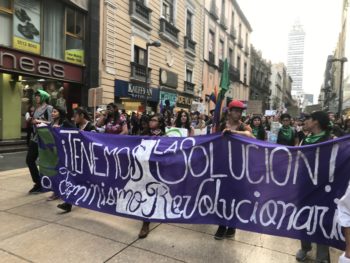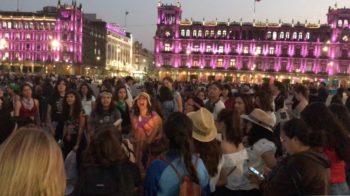The debate broke out because this year Mexican women’s groups organized two actions for the historic conmemoration of March 8, International Women’s Day. The march on Sunday in Mexico City leaves in the afternoon from the Monument to the Revolution to the Zocalo, with other marches planned in cities throughout the country. The 8M march, mirrored globally, has grown year after year in Mexico, alongside the growing violence against women and the growing anger over the lack of serious and effective responses to the insecurity crisis in which we live.
The traditional Women’s Day march remains the barometer of Mexico’s women’s movement and movements throughout the world. This is the day feminists openly and collectively express our positions in favor of a woman’s right to abortion, for decent and valued work, against patriarchy and violence, and in opposition to capitalism and extractivism. Convened by a wide range of feminist groups, the Mexico 2020 march is expected to be the largest in history.
The march is a public act to make our presence felt. The #undiasinmujeres (a day without women) strike on March 9 was conceived as an event to make our absence felt. The call to fo a strike, or work stoppage in the strict translation from the Spanish, intructs women not to go out in the streets, not to go to work, or carry out caring and house work, not to consume and not to attend college or school classes. The purpose is to push the government and socieity as a whole to do something about violence against women and to make clear the daily contribution of women to the economy and their communities.
The history of March 8 women’s strikes puts this year’s March 9th call in context. A look at the legacy of women’s strikes shows two basic themes. The first goes back to 1972 with the founding of the Wages for Housework movement. initiated by pioneering women thinkers and organizers, including Selma James and Silvia Federici, among others, in various parts of the world.
I talked with Selma James in London last October about the origin of the global women’s strikes. She said that in 2000, a group of Irish women requested support for a proposal for a day without women on March 8 in Ireland. The proposal was later globalized and became a common strategy in many countries, organized by autonomous groups of women from many sectors–sex workers, domestic workers, single mothers, victims of rape, an international network of black women, and groups in the LGBTQ community.
The central demand is a living wage for mothers and all people who do caring work. The concept of “housework” that began in the seventies has now been extended to what Federici calls “reproduction of life” and James calls “care work”. The concept encompasses not only work in the home, but everything that involves generating, supporting and caring for life, and not just human life, but the forms of life in society, in nature and on the planet that make human life possible. The approach focuses on the economic critique of how capitalism instrumentalizes the reproductive and unpaid care work of women and girls to obtain maximum exploitation of women’s labor and their continued oppression.
The second aspect, which is the main inspiration for the 2020 strike in Mexico, focuses on violence against women and the right to abortion. This use of the women’s strike has its precedent in 2015 in Argentina, with the demand of “Ni Una menos”-Not One Less, in protest of femicide. In the United States, the 2017 strike was organized with these demands and converged with the burgeoning #MeToo movement against sexual abuse and harassment.
This year, an international women’s strike is organized for March 8, embodying all these demands and calling on women to organize marches, rallies and talks. In fact, Mexico seems to be among the few countries in which the strike is scheduled for the 9th, and that rules out forms of public mobilization.
One of the most important tasks for feminist movements is to unite the two aspects–the fight against violnce and the fight for a living wage nd recognition of women’s work–because they are radically connected in the concept of body-territory and in anti-capitalist feminist praxis. Violence against women is exercised from a position of power over women’s bodies and over our autonomy. This power over women is exercised in the home, in the streets and in the workplace and it is fundamental to sustaining both the patriarchal system of control and capitalist exploitation.
The fact that a woman can be attacked any time, even and especially in intimate spheres generates an atmosphere of fear, expressed in a differing ways, among women of different classes, races and cultures. It inhibits our human development and restricts our autonomy. Mexico’s President Andrés Manuel López Obrador appeared totally oblivious to that reality in his many insenstive responses to the strike and to the phenomenon of violence against women in Mexican society. On several occasions, he stated that machismo and violence will end with the end of neoliberal values under his government. He distinguished in some way between capitalism, which he did not mention, and neoliberalism, and failed to acknowledge that the current economic system will not end by merely announcing its supposed demise.
The assumption that violence against women will go away now that a progresssive government is a sure way to fail to resolve or even diminsh the violence we experience as women. The roots of the violence go much deeper than changing values. It is not a problem of just correcting some men, and it’s not a problem of just ending impunity–although all these are aggravating factors. It is a problem with structural causes that are not being addressed and, in fact, are being actively maintained. To date, there are no government programs aimed at dismantling these structures in Lopez Obrador’s Fourth Transformation and attacks on women continue at the same levels or worse than in previous governments. Femicide, disappearances and abuse statistics are the tragic proof of the unextracted root of the violence.
The president and his followers have also repeatedly accused feminists of being manipulated in demanding a strike. AMLO has claimed that the strike is a plot of the opposition to weaken his goverment, a scheme built on the legitimate (but not priority, according to them) demands of women, but having behind it ulterior motives. This attitude reveals the same bedrock assumptions that cause the violence. In this logic, women have no agenda of our own, we lack independent judgment, we are easy to manipulate, and we do not understand that the system (now transformed by a new leftwing government) protects and benefits us. It is a paternalistic and condescending attitude that reflects gender discrimination and seeks to discredits the grassroots struggle of women.
Another distortion promoted by the media, government officials and part of the population is to reduce our issues to femicides alone. The media’s shortcut for ascribing the movement’s existence to the 137% increase in femicides over the last five years, and to cite the outrage over the recent gruesome and tragic cases of Ingrid, the woman murdered and cut up by her partner, and Fatima, the 7-year old girl abducted from school and abused and murdered, as the straw that broke the camel’s back of our complacency.
While it’s true that the cases caused massive indignaton, this is a reductionist way of portraying the movment. Women have been organizing against violence for decades, if not centuries. Femicide is the extreme expression of the violent system that kills, beats and threatens women in a thousand ways. It cannot be fixed by solving individual cases, although it is urgent to do so. We have to end the reign of terror that is maintained by inequality, and daily and systemic violence.
In this context, Mexico’s March 9 strike is not only justified, but necessary. It is a genuine expression from below that we will not allow this to continue. By demonstrating the economic impact of women’s work and protesting unfair and bad labor conditions for women’s work, the hope is government and society will wake up to their responsibility to end the violence. Another positive impact of the strike strategy is the public debate it has generated. Discussions in social networks, television and the papers reveal greater attention and awareness of the issues of violence and women’s rights,  and also expose the ignorance that exists around our demands. It has generated solidarity that helps to encourage and expand the women’s movement. While it’s true that part of the solidarity expressed in these weeks is hypocritical and opportunistic, if the movement actively rejects any attempt at co-optation, the insincere forces of the right that view the mobilization as another way to attack the MORENA government will fall away and are not likely to cause damage to the movement in the long term.
and also expose the ignorance that exists around our demands. It has generated solidarity that helps to encourage and expand the women’s movement. While it’s true that part of the solidarity expressed in these weeks is hypocritical and opportunistic, if the movement actively rejects any attempt at co-optation, the insincere forces of the right that view the mobilization as another way to attack the MORENA government will fall away and are not likely to cause damage to the movement in the long term.
This doesn’t mean that the Mexican March 9 strike doesn’t have its disadvantages as a tactic. It has also generated polarization, partisanship and backlash. If we follow the slogan “on the 9th, nobody moves”, the call could be an action of isolation, individualism and the atomization of our outrage, as well as being an action in which some women have more real possibilities to participate than others. As businesses grant permission to women workers to stay home the 9th, it could also become a symbolic gesture authorized by corporations and governments that doesn’t move us closer to a real break in the dominant power structures.
How can we follow up on a political act that seems to disperse, instead of concentrating, our collective power? How can we formulate clear messages? And most important: How do we assure that the void we create on March 9 is filled with content and commitments for March 10 and onwards?
Facing these challenges, it makes more sense a call to carry out the strike, but to use the day to organize: forums for discussion, group meetings to analyze and strategize, and possibly cultural, political and educational activities that help the movement to advance collectively. That way, we can move forward with public commitments and a constant confronting of the power structures that perpetuate the violence.
Originally published March 5 en desinformemonos.org. Text and photos: Laura Carlsen
 It’s impressive how a women’s mobilization of women, or rather a non-mobilization in the form of a stay-at-home strike, became the center of attention in Mexican politics and the headline of almost all recent articles on Mexico in the international press. This unprecedented coverage should be considered a breakthrough for awarenesss on violence against women and inequality in society, but the confusion, controversy and utter nonsense in the press regarding the woman’s strike has made it a dubious victory at best.
It’s impressive how a women’s mobilization of women, or rather a non-mobilization in the form of a stay-at-home strike, became the center of attention in Mexican politics and the headline of almost all recent articles on Mexico in the international press. This unprecedented coverage should be considered a breakthrough for awarenesss on violence against women and inequality in society, but the confusion, controversy and utter nonsense in the press regarding the woman’s strike has made it a dubious victory at best.
 and also expose the ignorance that exists around our demands. It has generated solidarity that helps to encourage and expand the women’s movement. While it’s true that part of the solidarity expressed in these weeks is hypocritical and opportunistic, if the movement actively rejects any attempt at co-optation, the insincere forces of the right that view the mobilization as another way to attack the MORENA government will fall away and are not likely to cause damage to the movement in the long term.
and also expose the ignorance that exists around our demands. It has generated solidarity that helps to encourage and expand the women’s movement. While it’s true that part of the solidarity expressed in these weeks is hypocritical and opportunistic, if the movement actively rejects any attempt at co-optation, the insincere forces of the right that view the mobilization as another way to attack the MORENA government will fall away and are not likely to cause damage to the movement in the long term.


